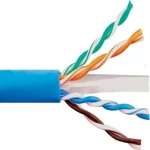Data Cabling Best Practices
When running new cables for any office, when installing cables, it a good idea to to pull extra cables in the backbone area for future growth, an extra cable is generally pulled to each workstation or desktop. This gives protection against pairs that may fail on voice cables during installation, and it also provides for expansion.
Always use a pull string when installing new cables. This makes it easier to pull other cables down the line and you don’t have to do drilling work each time.
- Cat6 or Cat5e Cable can be run upto 90 meter or 300 feet max. For longer distances, user Fiber optic cable.
- Cover the surfaces where the distribution hardware is mounted with fire-rated plywood or plywood that is painted
- with two coats of fire retardant paint.
- Always use Plenum rated or FT6 Cables in areas where there is plenum ceilng.
- Because most cables cannot be strung across the floor, it is recommended to use wire management hardware such as trays, baskets, ladders, and raceways. The conduit or casing should not be filled completely with the cables. There should be room for future expansion.
- Always use more cable than you need. Leave plenty of slack.
- Avoid cable stress
- It is desirable to have hubs/switches in rooms or closets, which are secure from unauthorized access.
- If it is necessary to run cable across the floor, cover the cable with cable protectors.
- After the cables have been installed, they will be tested for continuity. this ensures that all the cables are working properly so that the customer does not face any problem after the job is done. This saves time and resources for the Data Cabling company and the customer.
- Avoid exposing cables to areas of condensation and direct sunlight.
Data Cabling is an Art.
Data cabling is an art performed with skills, Knowledge and patience. These best practices surely can help improve Network performance, minimize the risk of failure, increasing the mean time between failures, reducing the installation time, and planning the maintenance costs.





